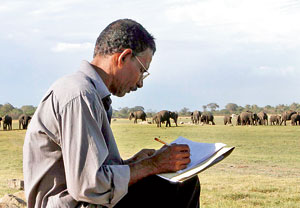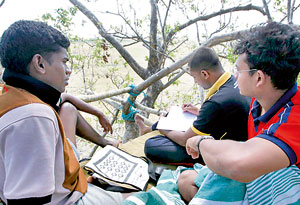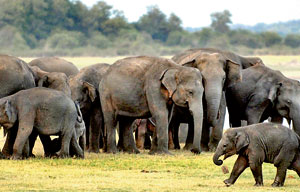| After a long bumpy ride to the heart of the Minneriya National Park, we saw hundreds of them – adults, sub-adults, juveniles and calves – lumbering towards a water-hole. The two observers of the Department of Wildlife Conservation (DWC) quickly started counting and making note of the number of elephants.
The observers had spotted 187 elephants at the waterhole from 6 a.m. till noon on the second day of the islandwide elephant census conducted by the Department of Wild Life Conservation. “We can’t be sure of the count. But, I don’t think I will make an error as elephants are not new to me,” said one observer. Elephant surveys are usually conducted during the peak drought period. In this method, known as the waterhole count, elephants are counted when they go in large numbers to big water- holes. The smaller waterholes dry up during the drought.
 |
| A man takes down data as elephants gather at the
water-hole in Minneriya |
 |
| Observers perchd on an observation post await the arrival of elephants |
 |
| How many calves hiding behind their elders may have been left out in the census? Pix by Sanka Vidanagama and Kanchana Kumara Ariyadasa |
The islandwide census which was a 48-hour survey from 6 p.m on Thursday to 6 p.m. on Saturday was the first of its kind in the country.
There were 1,553 observation points islandwide and upto 4,000 observers – wildlife department officials, volunteers and military personnel participated in the programme, DWC Deputy Director S.R.B. Dissanayake, said.
He said, volunteers and military men were given a training on how to conduct the census. In some areas villagers and civil defence forces also assisted the department officials, he said.
The observers with pencil and sheet of paper in hand marked the location where the elephants were sighted, the time, category and male-female ratio.
DWC official W.B.M. Wijesiri said although the animals did not pose a threat unless they were disturbed, the observers carried a shotgun for safety.
He said, one of the main classification of the jumbos was gender and to do this they observed their shapes. “While female elephants have straight and flat backs, the males have rounded backs,” he said.
However, counting and categorising the large number of elephants from the observation points, which are quite a distance away from the animals can give rise to inaccuracies.
Our own count on the number of elephants near the lake was more than 400. Moreover, we noticed baby elephants hiding behind their parents and this would have posed a big problem for the observers.
Commenting on our query about accuracy, the Deputy Director, Mr. Dissanayake said, if the observers are trained properly, precision can be ensured. “We are not counting the elephants one by one, this is more a survey. More than the numbers, we are collecting information on the population structure of the elephants - proportion of calves, adults and the percentage of juveniles,” he said.
As I was speaking to Mr. Dissanayake he suddenly yelled ‘run’. An elephant was charging towards the area where our jeeps were stopped, where photographers were clicking pictures and we were talking to the Deputy Director.
We jumped into the closest jeep and beat a hasty retreat. After following the convoy of jeeps for about 90 seconds, the jumbo gave up. Wild Life officials told us that the elephant had lost its young recently and hence the reason for its aggressiveness.
Mr. Dissanayake said another aspect of the survey was to find out how healthy the elephant population was. Based on the results, the DWC hopes to cordon off more protection zones for the elephants. He also said to curb the human-elephant conflict in unprotected areas, electrified fences will be put up to protect the villagers and their fields, he added.
However some scientists question the accuracy of the waterhole method.
A wildlife biologist, who did not want to be identified, said this method of census was used in India several times but had been proved a failure. “The census is not scientifically sound. You can’t cover every waterhole.”
The biologist said that most elephants are found outside national parks and come out at night, but, this survey concentrated on the interior of the parks.
Elaborating that this method was more assumption-based, the scientist said there was no guarantee that all the elephants would come to the waterholes. Moreover, Minneriya is a place where elephants can be spotted easily, whereas, there are several other places where the elephants do not come out to the waterholes.
“I believe the census is pointless. One should concentrate on unknown areas. Scientists pulled out from the census because of the methodology. There are thousands of waterholes in the South and the Central areas and you can’t man every one of them,” he said.
The biologist pointed out that the elephants that were counted in Minneriya may even go towards the Kaudulla National Park, which is just a few kilometres away, thereby increasing the chances of being counted twice over.
As quick-fix methods, such as the waterhole counts, are not accurate, technical methods need to be implemented. However, the latter requires a high degree of training, skill, expertise, funds, time and dedication, according to him.
Meanwhile, Wild Life minister S.M. Chandrasena told a news conference at Minneriya on Friday, that the aim of the census was to get an idea of the number of elephants in the country.“We don’t have a special reason to count tuskers. People say we are going to give away some tuskers. I can't handover tuskers to anyone as I wish. And, I don't want to,” Mr. Chandrasena said.
He said, he wanted to ensure that the country’s wildlife was protected adding that the elephants used for Peraheras (pageants) are from the Pinnawala Elephant Orphanage and not from the wild.
Reacting to the minister’s statement, Environmental lawyer Jagath Gunawardena said he was glad that the minister had changed his decision about the tuskers.
He said although they wanted to participate in the census, they pulled out on a matter of principle.
Mr. Gunawardena said partial surveys conducted earlier have revealed that 60 per cent of elephants were old, whereas, it shouldn’t be more than 40 per cent while juveniles and sub-adults constitute half the population.
|
